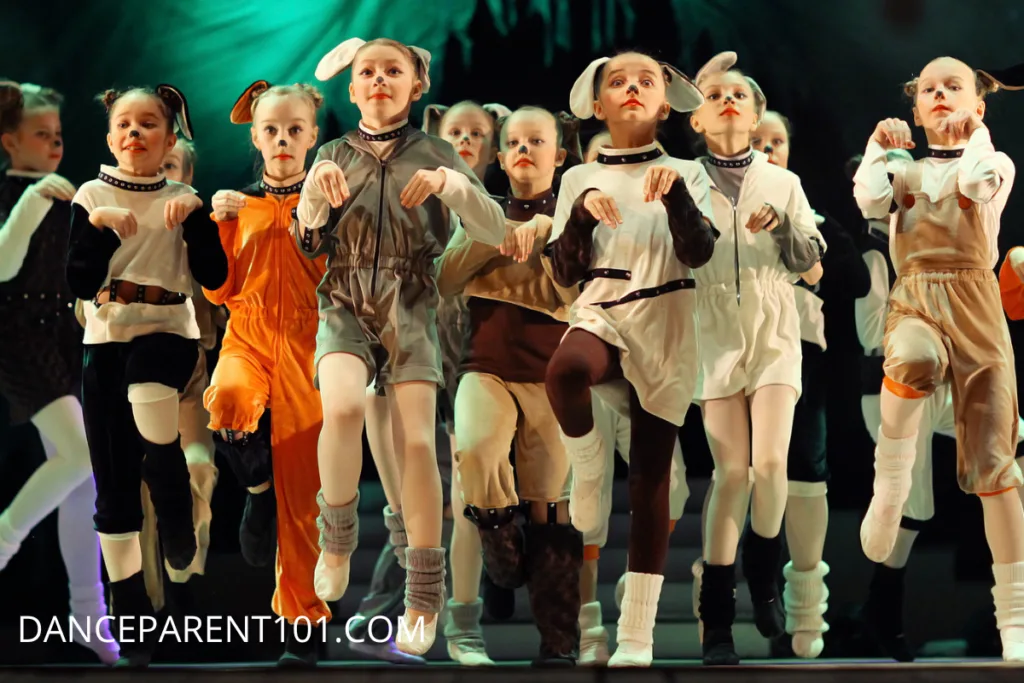Has your child been cast in a dance production at their dance studio and you’re not quite sure what this means? Well look no further we have all the information you need right here to help you understand what you and they are getting into!

A dance or company production at a dance competition is a performance that expresses a story with similar qualities to a musical or Broadway production. Dependent on the competition rules there is generally a minimum of 15 dancers on stage, with the duration of the performance being 8 minutes or less.
A production is generally created to perform at competitions but they can also be performed at a dance studio’s annual recital or concert.
A dance production goes beyond your regular troupe dance and some of the key elements of a dance production include:
1. A Theme or Story with Musical or Broadway Qualities
Many dance productions incorporate a narrative, theme, or concept that guides the performance. This might involve portraying characters, relationships, or abstract concepts that resonate with the audience.
Some themes are based on known musicals or movies where the music is readily available to piece together to create a narrative. Some studios will however take on a concept, event, genre of music, music artist, or abstract theme and create their own original production.
2. Costumes for a Production
You may find your dancer has more than one costume for a production, a change of shoes, or a quick change from pants to a skirt side of the stage.
Costumes are designed to align with the choreography and contribute to the overall storytelling and wow factor of a production.
3. The Group Dynamics
Dance productions typically feature larger groups of dancers around 15 or more. A studio will usually ask dancers of different ages and skills to participate in the production to cover the range of roles required to tell the story or deliver the concept and vision they have for the production.
Larger groups can also add to the wow factor of a production, but it is imperative that they work as a team in unison when required and in formation with spatial awareness.
4. Characters, Expression, and Stage Presence.
Unlike a jazz, ballet, or tap dance routine where you are generally required to smile and enjoy your dancing, a production may require dancers to fully embody their roles and connect emotionally with the choreography.
Dancers may have individual characters such as if doing ‘The Greatest Showman’ or may have the role of solider for example with many others if performing for example ‘Mulan’.
Dancers are expected to command the stage with confidence and charisma. Their engagement with the audience, combined with dynamic energy, contributes to the overall presentation.
5. Technical Skill Vs Entertainment Value?
While it is important that a production is entertaining for an audience, technical skill is equally vital in a dance production. For a production to have that wow factor, dancers must execute complex movements, formations, lifts, and transitions with finesse and accuracy.
6. The Choreography and Concept
A dance production involves the creation of a cohesive and imaginative choreographic concept. Choreographers weave together movements, formations, and emotions to tell a story or evoke a specific mood.
A production showcases the choreographer’s unique style and artistic voice.
7. Judging Criteria
Dance production performances are evaluated based on various criteria, which may include choreography, technique, creativity, storytelling, synchronization, presentation, and overall performance quality.
As the parent or dancer do you get a say on the theme, choreography, costumes, music, or theme of a production?
Generally no, parents and dancers do not get to have a say on the theme, choreography, costumes, music, or theme of a production.
Sometimes your studio may ask for suggestions if they are looking to create something no one has ever done before, but in general, your studio owner and teacher are doing what they do because they love it and have their own creative vision for their dancers and studios.
Overall, a dance production is a culmination of artistic expression, technical skill, teamwork, and creative interpretation.
A ‘Dance Production’ aims to leave a lasting impression on both the judges and the audience, showcasing the dancers’ and teachers dedication and passion.
